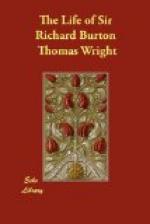The Preface is by Arbuthnot. He points out that there are three great Persian didactic works, viz.:—The Gulistan, or Rose Garden, by Sadi; The Nigaristan by Jawini; and The Beharistan by Jami. The Nigaristan contains 534 stories in prose and verse. Some particulars of it are given in Arbuthnot’s Persian Portraits (Quaritch, 1887), p. 106. “These three books,” to use Arbuthnot’s works, “abound in pure and noble sentiments such as are to be found scattered throughout the Sacred Books of the East, the Old and New Testaments, and the Koran.”
The two following extracts will give some idea of the contents and style of the Nigaristan:
Zohra[FN#712]
If Zohra plays the guitar a thousand years,
The musician’s song will always be this:
Try to become the subject of a good tale,
Since everyone who lives becomes a tale.
Fath Mousuli’s Prayer
After having been very prosperous and rich, Fath Mousuli fell into poverty and misery. After a while, however, when he had accustomed himself more to his position, he said, “O Lord, send me a revelation that I may know by what act I have deserved this gift, so that I may offer thanks for this favour.”
2. Translations from the Persian, by the late
E. Rehatsek.
i. A Persian Tract on the observances
of the Zenanah, pp. 1 to
10.
ii. A Persian Essay on Hospitality,
or Etiquette of Eating and
Drinking, pp. 20 to 29.
iii. A short Persian Manuscript
on Physiognomies, pp. 1 to 8.
The last consists of a preface and ten chapters. “These leaves,” we are told, “are the compendium of a treatise written by the Ema’n Fakhr-al-din Al-Ra’zy—may God overwhelm him with forgiveness— on the Science of Physiognomies.” We are told how the abode influences character; when the character of a man corresponds with that of a beast; that “the index of the dominant passion is the face;” that “the male is among all animals stronger and more perfect than the female,” and so on.
A short quotation must suffice:
“When does the character of a man correspond to that of a beast?”
“If a man has a long face, protuberant eyes, and the tip of his nose long, drawn out like the snout of a dog, because as we have explained above, external appearances and internal qualities are closely connected with each other, so that if a man happens to resemble some animal he will possess the nature of it also.”
3. Translations from the Persian and Arabic,
by the late
E. Rehatsek.
Persian.
i. Short anecdotes, stories
and fables picked out and translated
from the Nuzhat al Yaman, pp. 1 to 7.
ii. The Merzuban Namah, from
which animal fables have been
translated, pp. 7 to 21.
Arabic.
i. Selected historical and
other extracts from the celebrated
Arabic work, Al Moustairaf, pp. 1 to 5.
ii. Some extracts from the
well-known Siraj-ul-moluk, pp. 5 to 7.
iii. Twenty-five chapters of
Extracts from the Arabic Tuhfat
ekhoan us safa, under the title of “Discussion
between man and
animals before the King of the Jinns,” pp. 7
to 33.




